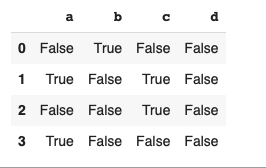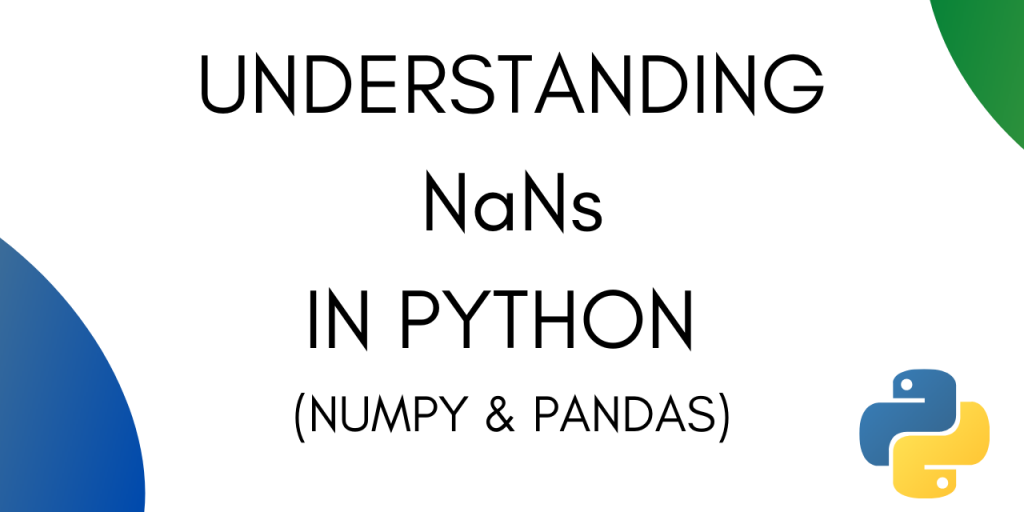NaN is short for Not a number. It is used to represent entries that are undefined. It is also used for representing missing values in a dataset.
The concept of NaN existed even before Python was created. IEEE Standard for Floating-Point Arithmetic (IEEE 754) introduced NaN in 1985.
NaN is a special floating-point value which cannot be converted to any other type than float.
In this tutorial we will look at how NaN works in Pandas and Numpy.
NaN in Numpy
Let’s see how NaN works under Numpy. To observe the properties of NaN let’s create a Numpy array with NaN values.
import numpy as np
arr = np.array([1, np.nan, 3, 4, 5, 6, np.nan])
pritn(arr)
Output :
[ 1. nan 3. 4. 5. 6. nan]
1. Mathematical operations on a Numpy array with NaN
Let’s try calling some basic functions on the Numpy array.
print(arr.sum())
Output :
nan
Let’ try finding the maximum from the array :
print(arr.max())
Output :
nan
Thankfully Numpy offers methods that ignore the NaN values while performing Mathematical operations.
2. How to ignore NaN values while performing Mathematical operations on a Numpy array
Numpy offers you methods like np.nansum() and np.nanmax() to calculate sum and max after ignoring NaN values in the array.
np.nansum(arr)
Output :
19.0
np.nanmax(arr)
6.0
If you have your autocompletion on in your IDE, you will see the following list of options while working with np.nan :

3. Checking for NaN values
To check for NaN values in a Numpy array you can use the np.isnan() method.
This outputs a boolean mask of the size that of the original array.
np.isnan(arr)
Output :
[False True False False False False True]
The output array has true for the indices which are NaNs in the original array and false for the rest.
4. Equating two nans
Are two NaNs equal to one another?
This can be a confusing question. Let’s try to answer it by running some python code.
a = np.nan
b = np.nan
These two statements initialize two variables, a and b with nan. Let’s try equating the two.
a == b
Output :
False
In Python we also have the is operator. Let’s try using that to compare the two variables.
a is b
Output :
True
The reason for this is that == operator compares the values of both the operands and checks for value equality. is operator, on the other hand, checks whether both the operands refer to the same object or not.
In fact, you can print out the IDs of both a and b and see that they refer to the same object.
id(a)
Output :
139836725842784
id(b)
Output :
139836725842784
NaN in Pandas Dataframe
Pandas DataFrames are a common way of importing data into python. Let’s see how can we deal with NaN values in a Pandas Dataframe.
Let’s start by creating a dataframe.
s = pd.DataFrame([(0.0, np.nan, -2.0, 2.0),
... (np.nan, 2.0, np.nan, 1),
... (2.0, 5.0, np.nan, 9.0),
... (np.nan, 4.0, -3.0, 16.0)],
... columns=list('abcd'))
s
Output :

1. Checking for NaN values
You can check for NaN values by using the isnull() method. The output will be a boolean mask with dimensions that of the original dataframe.
s.isnull()
Output :

2. Replacing NaN values
There are multiple ways to replace NaN values in a Pandas Dataframe. The most common way to do so is by using the .fillna() method.
This method requires you to specify a value to replace the NaNs with.
s.fillna(0)
Output :

Alternatively, you can also mention the values column-wise. That means all the NaNs under one column will be replaced with the same value.
values = {'a': 0, 'b': 1, 'c': 2, 'd': 3}
s.fillna(value=values)
Output :

You can also use interpolation to fill the missing values in a data frame. Interpolation is a slightly advanced method as compared to .fillna().
Interpolation is a technique with which you can estimate unknown data points between two known data points.
3. Drop rows containing NaN values
To drop the rows or columns with NaNs you can use the .dropna() method.
To drop rows with NaNs use:
df.dropna()
To drop columns with NaNs use :
df.dropna(axis='columns')
Conclusion
This tutorial was about NaNs in Python. We majorly focused on dealing with NaNs in Numpy and Pandas. Hope you had fun learning with us.
